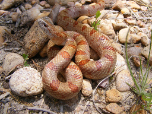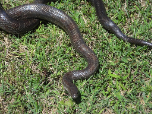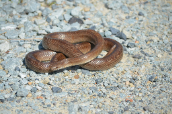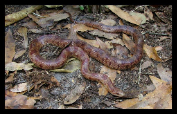Mole Kingsnake (Lampropeltis rhombomaculata)
Description: L. rhombomaculata is generally light brown or gray in color, with dark brown, orange, or reddish-brown blotching down the length of its body. It is capable of growing to a total length (including tail) of 30–40 inches. It is easily mistaken for the milk snake and the venomous copperhead, which both share the same type of habitat, and can have similar markings. Some specimens have their markings faded, to appear almost a solid brown color. Juveniles are generally more vivid in markings and coloration, with small reddish-colored markings on the head.
Habitat: The preferred habitat of the mole kingsnake is open fields with loose, dry soil, typically on the edge of a forested region.
Range: The mole kingsnake is found in the southeastern United States, but is absent from the Appalachian Mountains.
Diet: Its diet consists primarily of rodents, but it will also consume lizards, frogs and occasionally other snakes.
Reproduction: Male and female mole kingsnakes mate around May–June during late spring to early summer. Females leave behind pheromone trails for males to sense through their forked tongues. Mating events in a laboratory setting were recorded to have lasted over two hours. After mating, females choose their nesting sites underground or in rotting logs and leave their 10-12 eggs to hatch in the summer. The mother does not stay behind to nurture her offspring, usually leaving right after she laid the eggs. It takes about ten days for the hatched snakes to be fully independent. The hatchlings and eggs of L. rhombomaculata are both of smaller average size than those of L. calligaster.
Status: Listed as Least Concern in view of its wide distribution, tolerance of a degree of habitat modification, presumed large population, and because it is unlikely to be declining fast enough to qualify for listing in a more threatened category.
Taxonomy: On 10-11-2022 Lampropeltis calligaster rhombomaculata was replaced by Lampropeltis rhombomaculata.
»» Kingdom: Animalia - Animals
»» Phylum: Chordata - Chordates
»» Subphylum: Vertebrata - Vertebrates
»» Class: Reptilia - Reptiles
»» Order: Squamata - Scaled Reptiles
»» Suborder: Serpentes
»» Superfamily: Colubroidea
»» Family: Colubridae - Colubrids
»» Genus: Lampropeltis
»» Species: Lampropeltis rhombomaculata - Mole Kingsnake
This article uses material from the Wikipedia article "Lampropeltis rhombomaculata", which is released under the Creative Commons Attribution-Share-Alike License 3.0. Content may have been omitted from the original, but no content has been changed or extended.
|








